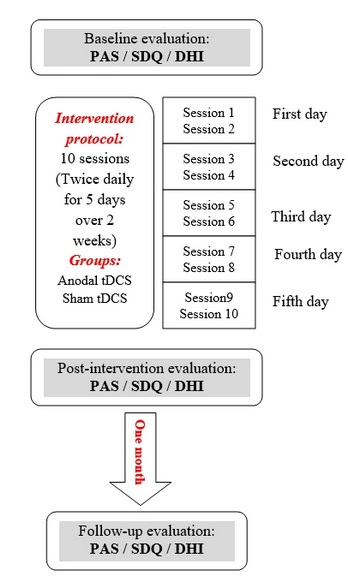Adjunctive transcranial direct current stimulation to improve swallowing functions in Parkinson's disease
DOI:
https://doi.org/10.17179/excli2023-6496Keywords:
Parkinson's disease, dysphagia, transcranial Direct Current Stimulation, conventional dysphagia treatment, combination therapyAbstract
Swallowing problems are frequent in Parkinson's disease (PD). The aim of this study was to determine the effectiveness of combined transcranial Direct Current Stimulation (tDCS) and Conventional Dysphagia Therapy (CDT) on dysphagia in PD patients. Twenty PD patients with dysphagia were randomized into two groups: combination therapy (anodal tDCS plus CDT) and sham tDCS combined with CDT. Anodal or sham tDCS, bilaterally over the pharyngeal motor cortex, was applied with one mA during the first 20 min (real) or 30 s (sham) of CDT, which was delivered for 30 min. Both groups received twice-daily treatment sessions within two weeks. Swallowing functions were evaluated before, immediately, and one month after the intervention via the Penetration-Aspiration Scale (PAS), and the Swallowing Disorder Questionnaire (SDQ) as the primary outcome measures, and the Dysphagia Handicap Index (DHI) as the secondary outcome measure. The results showed a significant improvement of PAS scores from baseline to post-intervention and baseline to follow-up in both groups without significant differences between groups (t=0.03, p=0.973, and t=1.27, p=0.22 for post-intervention and follow-up time points, respectively). The results showed a significant reduction of SDQ and DHI scores in both groups after the intervention, but the magnitude of the change was significantly larger in the anodal tDCS group at the post-intervention (ta=2.58, pa=0.019 and tb=2.96, pb=0.008) and follow-up (ta=2.65, pa=0.016 and tb=2.97, pb=0.008) time points. This study provides preliminary evidence that bi-hemispheric anodal tDCS combined with CDT enhances swallowing functions in patients with Parkinson's disease more than CDT alone.

Downloads
Published
How to Cite
License
Copyright (c) 2024 Ali Akbar Dashtelei, Michael A. Nitsche, Mohammad Ali Salehinejad, Amir Hassan Habibi, Jalal Bakhtyiari, Ahmad Reza Khatoonabadi

This work is licensed under a Creative Commons Attribution 4.0 International License.
Authors who publish in this journal agree to the following terms:
- The authors keep the copyright and grant the journal the right of first publication under the terms of the Creative Commons Attribution license, CC BY 4.0. This licencse permits unrestricted use, distribution and reproduction in any medium, provided that the original work is properly cited.
- The use of general descriptive names, trade names, trademarks, and so forth in this publication, even if not specifically identified, does not imply that these names are not protected by the relevant laws and regulations.
- Because the advice and information in this journal are believed to be true and accurate at the time of publication, neither the authors, the editors, nor the publisher accept any legal responsibility for any errors or omissions presented in the publication. The publisher makes no guarantee, express or implied, with respect to the material contained herein.
- The authors can enter into additional contracts for the non-exclusive distribution of the journal's published version by citing the initial publication in this journal (e.g. publishing in an institutional repository or in a book).





